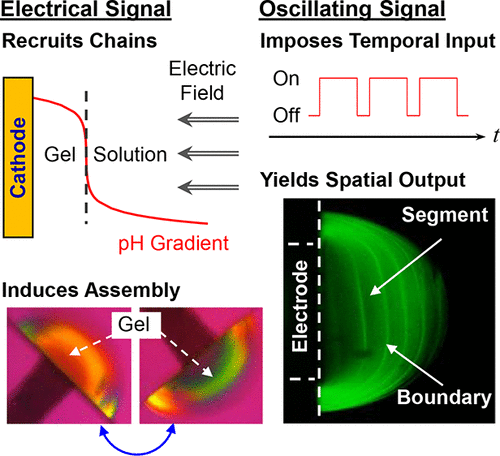当前位置:
X-MOL 学术
›
Biomacromolecules
›
论文详情
Our official English website, www.x-mol.net, welcomes your feedback! (Note: you will need to create a separate account there.)
Electrical Programming of Soft Matter: Using Temporally Varying Electrical Inputs To Spatially Control Self Assembly
Biomacromolecules ( IF 6.2 ) Pub Date : 2017-12-29 00:00:00 , DOI: 10.1021/acs.biomac.7b01464 Kun Yan 1 , Yi Liu 2, 3 , Jitao Zhang 3 , Santiago O. Correa 4 , Wu Shang 3 , Cheng-Chieh Tsai 5 , William E. Bentley 2, 3 , Jana Shen 5 , Giuliano Scarcelli 3 , Christopher B. Raub 4 , Xiao-Wen Shi 1 , Gregory F. Payne 2, 3
Biomacromolecules ( IF 6.2 ) Pub Date : 2017-12-29 00:00:00 , DOI: 10.1021/acs.biomac.7b01464 Kun Yan 1 , Yi Liu 2, 3 , Jitao Zhang 3 , Santiago O. Correa 4 , Wu Shang 3 , Cheng-Chieh Tsai 5 , William E. Bentley 2, 3 , Jana Shen 5 , Giuliano Scarcelli 3 , Christopher B. Raub 4 , Xiao-Wen Shi 1 , Gregory F. Payne 2, 3
Affiliation

|
The growing importance of hydrogels in translational medicine has stimulated the development of top-down fabrication methods, yet often these methods lack the capabilities to generate the complex matrix architectures observed in biology. Here we show that temporally varying electrical signals can cue a self-assembling polysaccharide to controllably form a hydrogel with complex internal patterns. Evidence from theory and experiment indicate that internal structure emerges through a subtle interplay between the electrical current that triggers self-assembly and the electrical potential (or electric field) that recruits and appears to orient the polysaccharide chains at the growing gel front. These studies demonstrate that short sequences (minutes) of low-power (∼1 V) electrical inputs can provide the program to guide self-assembly that yields hydrogels with stable, complex, and spatially varying structure and properties.
中文翻译:

软物质的电气编程:使用临时变化的电气输入来空间控制自组装
水凝胶在转化医学中的重要性日益提高,刺激了自上而下的制备方法的发展,但这些方法通常缺乏生成生物学中观察到的复杂基质结构的能力。在这里,我们表明,随时间变化的电信号可以提示自组装多糖,以可控制地形成具有复杂内部模式的水凝胶。来自理论和实验的证据表明,内部结构是通过触发自组装的电流与电位(或电场)之间微妙的相互作用而形成的,而电位(或电场)则吸收并似乎将多糖链定向在生长的凝胶前沿。
更新日期:2017-12-29
中文翻译:

软物质的电气编程:使用临时变化的电气输入来空间控制自组装
水凝胶在转化医学中的重要性日益提高,刺激了自上而下的制备方法的发展,但这些方法通常缺乏生成生物学中观察到的复杂基质结构的能力。在这里,我们表明,随时间变化的电信号可以提示自组装多糖,以可控制地形成具有复杂内部模式的水凝胶。来自理论和实验的证据表明,内部结构是通过触发自组装的电流与电位(或电场)之间微妙的相互作用而形成的,而电位(或电场)则吸收并似乎将多糖链定向在生长的凝胶前沿。



























 京公网安备 11010802027423号
京公网安备 11010802027423号